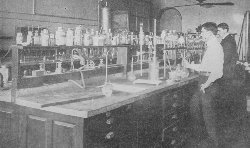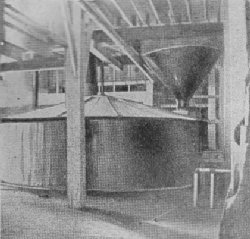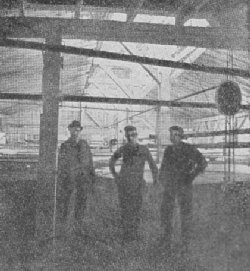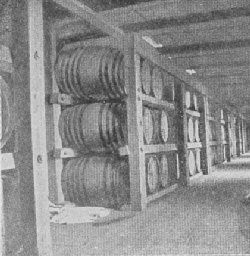Bourbon whisky is made from rye and malted corn. Gin is produced by mixing common spirits with juniper berries. Frequently other materials are used for flavoring, such as cardamon seed and oil of fennel. Liquors are made from brandy and alcohol by flavoring them with aromatic substances, such as orange peel, absinthe and anise; then the flavored liquid is distilled, and after distillation, it is colored with caramel and sweetened in most cases. The manufacture of whisky will serve as a type for the manufacture of other spirituous liquors. The first step in the process is the saccharifying of the grain—that is, turning the starch into sugar. The grain is mixed with malt and ground in a suitable mill and then run into a mash tub, where it is agitated with water at a temperature of 150 degrees Fahrenheit. The mashing process is continued until the starch is changed entirely into malt sugar or maltose. This requires from one to five hours, according to the amount of grain in the mash. Malt contains a substance known as "diastase," which possesses the remarkable property of turning starch into maltose or malt sugar. It is for this reason that malt is added to the grain in the mash tub. Starch is changed by prolonged boiling into dextrin, which does not ferment readily, while maltose ferments very easily. Great care, therefore, is taken during the mashing process that the dextrin formation is reduced, to a minimum. This is done by keeping the temperature near 150 degrees during the whole process. The liquor obtained in the mash tub is called "wort." When the wort is as strong as possible, it is drained off, and the grain is treated with a fresh supply of water and the wort so obtained is added to the first. The wort, on coming from the mash tub, must be cooled rapidly, otherwise an acid fermentation will set in which produces vinegar, and the presence of such substance is undesirable. The wort is cooled by allowing it to trickle over cold pipes, which are kept at a low temperature by some method ofartificial refrigeration similar to that by which ice is manufactured. It takes about five hours to reduce the contents of the mash tub to a temperature of 60 degrees.
The old stills were based on this principle, and many such stills are used today in Scotland and Ireland. They consist of large flat-bottomed vessels of copper set in brickwork and heated underneath by direct firing. The still is connected at the top with a long spiral pipe called a "worm," which passes through a tank of cold water, where the alcoholic vapors are cooled and the distillate is collected at the other end of the worm in a suitable tank. This method of distillation is wasteful of fuel and for that reason a number of devices have been introduced for reducing the cost of the product and increasing the quality. The improved stills are somewhat complicated in construction, and they are continuous in action; that is, the liquor to be rectified is fed in a steady stream without interruption to the process and the rectified spirits are drawn off continuously. A standard still consists of two columns made of wood, copper lined, called respectively the "analyzer" and the "rectifier." The analyzer is divided into a number of compartments by perforated copper plates, supplied with valves opening upward. Small pipes pass through each plate, projecting about half an inch above each plate and reaching down into small copper pans placed on the plate below. From the analyzer the vapors enter the rectifier, which also is divided into compartments with perforated plates until near the top of the column, which is free from plates. There the finished spirit is held back and carried away to the condensing worm. The liquor to be distilled is pumped through a zigzag pipe which circulates through the rectifier. When it reaches the bottom of the rectifier, it is entirely changed into vapor. The vapor then goes to the analyzer, which is heated from below by steam. The water condenses and runs off at the bottom of the analyzer; the vapors of the alcohol pass into the rectifier, where they circulate through compartments, and as they ascend they are almost entirely freed from water and fusel oil. The vapor then passes through a condensing worm, where it is thoroughly cooled and liquefies, running into storage tanks.
A TINY TYPEWRITER |



